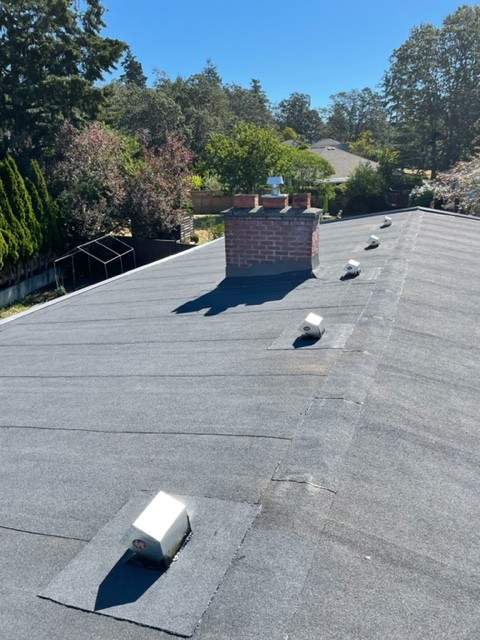You’re not alone if you’ve ever noticed an unsightly stain on your roof. Roof stains are a common problem for homeowners and can come in various colors, each indicating a different issue. But what do these stains mean, and how can you prevent them from appearing? This article delves into roof stains, breaks down each color, and explains what it signifies.
By understanding what causes each type of stain, you’ll be able to take the necessary steps to keep your roof looking its best and avoid costly repairs in the future. Let’s find out everything you need to know about roof stains.
The Types of Roof Stains
Below is a list of the types of roof stains, what their color means, and how you can avoid them.
1. Black or Green Streaks
These stains often occur due to the growth of algae known as Gloeocapsa Magma. When you see green stains, they usually indicate the presence of Gloeocapsa Magma.
However, not all Gloeocapsa Magma-induced stains are green. In some instances, the green stains usually have black overlaying stains.
The black streaks you see are secretions that the Gloeocapsa Magma bacteria make to protect themselves from the sun’s ultraviolet rays. Another instance where black streaks appear is when the algae feed on the limestone filler used in asphalt shingles.
Whenever the bacteria feeds on the limestone, the resultant effect is often black streaks on your roof.
Prevention
To avoid black streaks, you can clean your roof regularly and install a zinc or copper strip at the ridge of your roof. The strip will release metal ions as rainwater runs down the roof, killing the algae and preventing further growth. Additionally, you can also trim back overhanging branches. This can help reduce the shade and moisture on your roof, making it less conducive to algae growth.
2. Rust-Colored Stains
These stains are caused by metal roof panels exposed to moisture and oxygen. Over time, the metal will rust, creating an unsightly stain on your roof. Your roofing sheets are not very liable to rust and corrosion since they are often made of asphalt shingles. However, the metal elements in your roof’s overall construction are highly susceptible to rust and corrosion.
Rust-colored stains can come from other components like the flashings along the chimneys, vents, and other penetrations. When you start noticing rust-colored stains on your roof, it indicates that water has begun to seep through your roof.
Prevention
You can avoid rust-colored stains by properly installing and sealing your roof panels to prevent moisture from getting in. Additionally, you can install a roof ventilation system to help keep the roof cool and dry, reducing the risk of rusting.
Regular roof maintenance and inspection can also help identify and address any potential sources of moisture before they cause significant damage.
3. White Powdery Substance
This type of stain forms when water dissolves minerals from the roof tiles and deposits them on the roof surface. In other words, the presence of white stains indicates the presence of hard water buildup from air conditioning equipment or a cooler.
These white stains often inhibit the lower areas of your asphalt shingle roof beneath the cooling units, making them less visible.
Prevention
Ensuring that your roof has proper ventilation and drainage is important to avoid this type of stain. This will help prevent water from sitting on the roof and dissolving the minerals in the roof tiles.
Additionally, a professional can periodically clean your roof to remove any buildup of hard water mineral deposits.
4. Brown Stains
These stains can occur due to various factors, including tree sap, bird droppings, and algae. When you see brown stains on your roof, moss or other related organic elements have begun to grow and thrive.
Generally, brown stains can be difficult to remove and can significantly impact the appearance of your roof.
Prevention
To avoid brown stains, you should clean your roof regularly and address any potential sources of debris. This can include trimming back overhanging trees, installing bird deterrents, and cleaning up any debris accumulated on your roof.
Furthermore, consider installing a zinc or copper strip at the ridge of your roof. Having such a structure on your roof can help prevent the growth of algae and minimize the risk of brown stains.
5. Asphalt Bleed-Through
Asphalt bleed-through is a type of roof stain that occurs when the asphalt in your shingles begins to deteriorate. When the asphalt in your roof shingles begins to deteriorate, the oils in the asphalt rise to the surface, causing a dark, unsightly stain.
This type of stain indicates that your roof is reaching the end of its lifespan and that it may be time to consider replacing it.
Prevention
You can avoid Asphalt bleed-through by having a professional inspect your roof regularly and address any potential issues early. This may include repairing damaged or missing shingles, addressing leaks, and ensuring that your roof has proper ventilation.
All of these will help prolong your roof’s lifespan. However, if your roof is ultimately reaching the end of its lifespan, it may be time to consider replacing it to prevent further damage and ensure that your home is protected.
Additionally, you should always use a high-quality, algae-resistant roofing material. It will help prevent the growth of algae and reduce the risk of Asphalt bleed-through.
Conclusion
If you need roofing services, you can contact us at Shoreline Roofing. We have a team of experienced professionals who can offer you quality roofing services and help keep your roof in top condition.
Call us today at (250) 413-7967 or fill out our contact form to learn more about how we can help you with your roofing needs.

